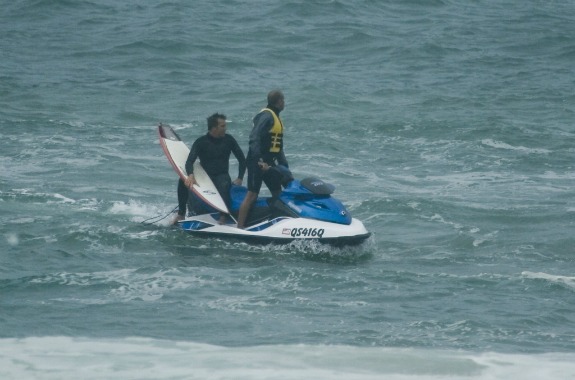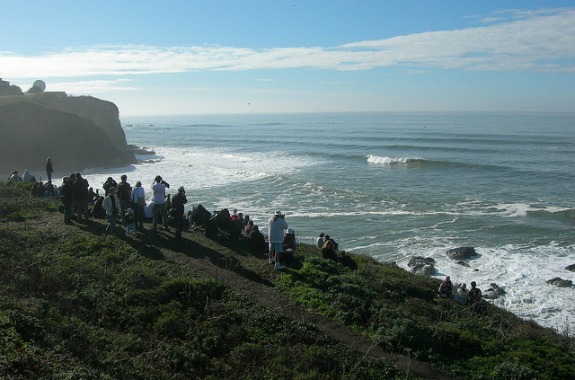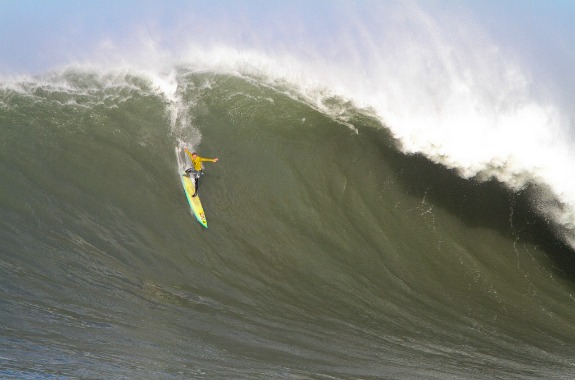Where to Watch the Biggest Waves Break
From Waimea Bay to “Mavericks,” here are some superb sites to watch surfers catch the biggest breakers in the world this winter
Giant counterclockwise cyclones in the Gulf of Alaska generate huge swells that manifest, finally, as the things surfers dream of. This giant wave is breaking at Jaws, a legendary site on Maui. Photo courtesy of Flickr user Jeff Rowley.
The start of the northern meteorological winter on December 1 will bring with it short days of darkness, blistering cold and frigid blizzards. For many people, this is the dreariest time of the year. But for a small niche of water-happy athletes, winter is a time to play, as ferocious storms send rippling rings of energy outward through the ocean. By the time they reach distant shores, these swells have matured into clean, polished waves that barrel in with a cold and ceaseless military rhythm; they touch bottom, slow, build and, finally, collapse in spectacular curls and thundering white water. These are the things of dreams for surfers, many of whom travel the planet, pursuing giant breakers. And surfers aren’t the only ones with their eyes on the water—for surfing has become a popular spectator sport. At many famed breaks, bluffs on the shore provide fans with thrilling views of the action. The waves alone are awesome—so powerful they may seem to shake the earth. But when a tiny human figure on a board as flimsy as a matchstick appears on the face of that incoming giant, zigzagging forward as the wave curls overhead and threatens to crush him, spines tingle, hands come together in prayer, and jaws drop. Whether you like the water or not, big-wave surfing is one of the most thrilling shows on the planet.
The birth of big-wave surfing was an incremental process that began in the 1930s and ’40s in Hawaii, especially along the north-facing shores of the islands. Here, 15-foot waves were once considered giants, and anything much bigger just eye candy. But wave at a time, surfers stoked up their courage and ambition. They surfed on bigger days, used lighter and lighter boards that allowed swifter paddling and hunted for breaks that consistently produced monsters. One by one, big-wave spots were cataloged, named and ranked, and wave at a time, records were set. In November 1957, big-wave pioneer Greg Noll rode an estimated 25-footer in Waimea Bay, Oahu. In 1969, Noll surfed what was probably a 30-plus-footer, but no verified photos exist of the wave, and thus no means of determining its height. Fast-forwarding a few decades, Mike Parsons caught a 66-foot breaker in 2001 at Cortes Bank, 115 miles off San Diego, where a seamount rises to within three feet of the surface. In 2008, Parsons was back at the same place and caught a 77-footer. But Garrett McNamara outdid Parsons and set the current record in November 2011, when he rode a 78-foot wave off the coast of Portugal, at the town of Nazare.

In the 1990s, the advent of “tow-in” surfing using jet skis allowed surfers to consistently access huge waves that otherwise would have been out of reach. Photo courtesy of Flickr user Michael Dawes.
But these later records may not have been possible without the assistance of jet skis, which have become a common and controversial element in the pursuit of giant waves. The vehicles first began appearing in the surf during big-wave events in the early 1990s, and for all their noise and stench, their appeal was undeniable: Jet skis made it possible to access waves 40 feet and bigger, and whose scale had previously been too grand for most unassisted surfers to reach by paddling. Though tow-in surfing has given a boost to the record books, it has also heightened the danger of surfing, and many surfers have died in big waves they might never have attempted without jet-ski assistance. Not surprisingly, many surfers have rejected tow-in surfing as an affront to the purity of their relationship with waves—and they still manage to catch monsters. In March 2011, Shane Dorian rode a 57-foot breaker at the famed Jaws break in Maui, unassisted by a belching two-stroke engine. But many big-wave riders fully endorse tow-in surfing as a natural evolution of the sport. Surfing supertstar Laird Hamilton has even blown off purists who continue to paddle after big waves without jet skis as “moving backward.” Anyway, in a sport that relies heavily on satellite imagery, Internet swell forecasts and red-eye flights to Honolulu, are we really complaining about a little high-tech assistance?
For those wishing merely to watch big waves and the competitors that gather to ride them, all that is needed is a picnic blanket and binoculars—and perhaps some help from this swell forecast website. Following are some superb sites to watch surfers catch the biggest breakers in the world this winter.
Waimea Bay, North Shore of Oahu. Big-wave surfing was born here, largely fueled by the fearless vision of Greg Noll in the 1950s. The definition of “big” for extreme surfers has grown since the early days, yet Waimea still holds its own. Fifty-foot waves can occur here—events that chase all but the best wave riders from the water. When conditions allow, elite surfers participate in the recurring Quicksilver Eddie Aikau Invitational. Spectators teem on the shore during big-swell periods, and while surfers may fight for their ride, you may have to fight for your view. Get there early.
Jaws, North Shore of Maui. Also known as Peahi, Jaws produces some of the most feared and attractive waves on earth. The break—where 50-footers and bigger appear almost every year—is almost strictly a tow-in site, but rebel paddle-by-hand surfers do business here, too. Twenty-one pros have been invited to convene at Jaws this winter for a paddle-in competition sometime between December 7 and March 15. Spectators are afforded a great view of the action on a high nearby bluff. But go early, as hundreds will be in line for the best viewing points. Also, bring binoculars, as the breakers crash almost a mile offshore.

When the surf’s up, crowds gather on the coastal bluffs to watch at Mavericks, near San Francisco. Photo courtesy of Flickr user emilychang.
Mavericks, Half Moon Bay, California. Mavericks gained its reputation in the 1980s and ’90s, during the revival of big-wave surfing, which lost some popularity in the 1970s. Named for a German Shepherd named Maverick who took a surgy swim here in 1961, the site (which gained an “s” but never an official apostrophe) generates some of the biggest surfable waves in the world. Today, surfing competitions, like the Mavericks Big Wave Contest and the Mavericks Invitational, are held each year. The waves of Mavericks crash on a vicious reef, making them predictable (sandy bottoms will shift and change the wave form) but nonetheless hazardous. One of the best surfers of his time, Mark Foo died here in 1994 when his ankle leash is believed to have snagged on the bottom. Later, the waves claimed the life of Hawaiian surfing star Sion Milosky. A high bluff above the beach offers a view of the action. As at Jaws, bring binoculars.

Murky, frigid water breaks in 40- and 50-foot waves every year during periods of high swell at Mavericks. Photo courtesy of Flickr user rickbucich.
Ghost Trees, Monterey Peninsula, California. This break hits peak form under the same swell conditions that get things roaring at Mavericks, just a three-hour drive north. Ghost Trees is a relatively new attraction for big-wave riders. Veteran surfer Don Curry says he first saw it surfed in 1974. Decades would pass before it became famous, and before it killed pro surfer (and a pioneer of nearby Mavericks) Peter Davi in 2007. For surfing spectators, there are few places quite like Ghost Trees. The waves, which can hit 50 feet and more, break just a football field’s length from shore.
Mullaghmore Head, Ireland. Far from the classic Pacific shores of big-wave legend and history, Mullaghmore Head comes alive during winter storms in the North Atlantic. The location produces waves big enough that surfing here has become primarily a jet ski-assisted game. In fact, the event period for the Billabong Tow-In Session at Mullaghmore began on November 1 and will run through February 2013. Just how big is Mullaghmore Head? On March 8, 2012, the waves here reached 50 feet, as determined by satellite measurements. A grassy headland provides an elevated platform from which to see the show. Bundle up if you go, and expect cold, blustery conditions.
Other big wave breaks:
Teahupoo, Tahiti. This coveted break blooms with big swells from the Southern Ocean—usually during the southern winter. Teahupoo is famed for its classic tube breakers.
Shipsterns Bluff, Tasmania. Watch for this point’s giants to break from June through September.
Punta de Lobos, Chile. Channeling the energy of the Southern Ocean into huge but glassy curlers, Punta de Lobos breaks at its best in March and April.
Todos Santos Island, Baja California, Mexico. Todos Santos Island features several well-known breaks, but “Killers” is the biggest and baddest. The surf usually peaks in the northern winter.
There is another sort of wave that thrills tourists and spectators: the tidal bore. These moon-induced phenomena occur with regularity at particular locations around the world. The most spectacular to see include the tidal bores of Hangzhou Bay, China, and Araguari, Brazil—each of which has become a popular surfing event.
Planning Your Next Trip?
Explore great travel deals
Smithsonian magazine participates in affiliate link advertising programs. If you purchase an item through these links, we receive a commission.
/https://tf-cmsv2-smithsonianmag-media.s3.amazonaws.com/accounts/headshot/Off-Road-alastair-bland-240.jpg)

/https://tf-cmsv2-smithsonianmag-media.s3.amazonaws.com/accounts/headshot/Off-Road-alastair-bland-240.jpg)